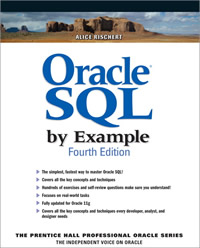SEARCH
Disclaimer: Authors have full rights over their works. Reproduction of any part of the content is prohibited without prior authorization.
BOOK ORACLE SQL BY EXAMPLE - 4TH ED
SUMMARY
-
Items Found: 127
- Chapter 1. SQL and Data
- What Is SQL?
- Why Learn SQL?
- An Introduction to Databases
- Lab 1.1. The Relational Database
- Lab 1.2. Data Normalization and Table Relationships
- Lab 1.3. The STUDENT Schema Diagram
- Chapter 2. SQL: The Basics
- Lab 2.1. The SQL Execution Environment
- Lab 2.2. The Anatomy of a SELECT Statement
- Lab 2.3. An Introduction to SQL*Plus
- Chapter 3. The WHERE and ORDER BY Clauses
- Lab 3.1. The WHERE Clause
- Lab 3.2. The ORDER BY Clause
- Chapter 4. Character, Number, and Miscellaneous Functions
- Data Types
- Reading Syntax Diagrams
- Lab 4.1. Character Functions
- Lab 4.2. Number Functions
- Lab 4.3. Miscellaneous Single-Row Functions
- Chapter 5. Date and Conversion Functions
- Lab 5.1. Applying Oracle’s Date Format Models
- Lab 5.2. Performing Date and Time Math
- Lab 5.3. Understanding the TIMESTAMP and TIME ZONE Data Types
- Lab 5.4. Performing Calculations with the Interval Data Types
- Lab 5.5. Converting from One Data Type to Another
- Chapter 6. Aggregate Functions, GROUP BY, and HAVING Clauses
- Lab 6.1. Aggregate Functions
- Lab 6.2. The GROUP BY and HAVING Clauses
- Chapter 7. Equijoins
- Lab 7.1. The Two-Table Join
- Lab 7.2. Joining Three or More Tables
- Chapter 8. Subqueries
- Lab 8.1. Simple Subqueries
- Lab 8.2. Correlated Subqueries
- Lab 8.3. Inline Views and Scalar Subquery Expressions
- Lab 8.4. ANY, SOME, and ALL Operators in Subqueries
- Oracle SQL By Example - 4th Ed
- Chapter 9. Set Operators
- Lab 9.1. The Power of UNION and UNION ALL
- Lab 9.2. The MINUS and INTERSECT Set Operators
- Chapter 10. Complex Joins
- Lab 10.1. Outer Joins
- Lab 10.2. Self-Joins
- Chapter 11. Insert, Update, and Delete
- Lab 11.1. Creating Data and Transaction Control
- Lab 11.2. Updating and Deleting Data
- Lab 11.3. The SQL Developer Data Tab
- Chapter 12. Create, Alter, and Drop Tables
- Lab 12.1. Creating and Dropping Tables
- Lab 12.2. Altering Tables and Manipulating Constraints
- Chapter 13. Indexes, Sequences, and Views
- Lab 13.1. Indexes
- Lab 13.2. Sequences
- Lab 13.3. Views
- Chapter 14. The Data Dictionary, Scripting, and Reporting
- Lab 14.1. The Oracle Data Dictionary Views
- Lab 14.2. Scripting and Reporting
- Chapter 15. Security
- Lab 15.1. Users, Privileges, Roles, and Synonyms
- Chapter 16. Regular Expressions and Hierarchical Queries
- Lab 16.1. Regular Expressions
- Lab 16.2. Hierarchical Queries
- Chapter 17. Exploring Data Warehousing Features
- Lab 17.1. Advanced SQL Concepts, Analytical Functions, and the WITH Clause
- Lab 17.2. ROLLUP and CUBE Operators
- Chapter 18. SQL Optimization
- Lab 18.1. The Oracle Optimizer and Writing Effective SQL Statements
- Appendix A. Answers to Quiz Questions
- Chapter 1
- Chapter 2
- Chapter 3
- Chapter 4
- Chapter 5
- Chapter 6
- Chapter 7
- Chapter 8
- Chapter 9
- Chapter 10
- Chapter 11
- Chapter 12
- Chapter 13
- Chapter 14
- Chapter 15
- Chapter 16
- Chapter 17
- Chapter 18
- Appendix B. SQL Formatting Guide
- Case
- Formatting SQL Code
- SQL Developer
- Appendix C. SQL*Plus Command Reference
- SQL*Plus Commands Supported in SQL Developer
- SQL*Plus Commands
- Predefined SQL*Plus Variables
- The LOGIN.SQL and GLOGIN.SQL Files
- Formatting Output in SQL*Plus
- Editing in SQL*Plus
- SQL*Plus Line Editor Editing Commands
- Using the SQL*Plus Line Editor to Save and Retrieve Files
- Oracle SQL By Example - 4th Ed
- Command Scripts in SQL*Plus
- Appendix D. STUDENT Database Schema
- Appendix E. Table and Column Descriptions
- Appendix F. Additional Example Tables
- Chapter 4: Character, Number, and Miscellaneous Functions
- Chapter 5: Date and Conversion Functions
- Chapter 10: Complex Joins
- Chapter 11: Insert, Update, and Delete
- Chapter 16: Regular Expressions and Hierarchical Queries
- Chapter 17: Exploring Data Warehousing Features
- Appendix G. Navigating the Oracle Documentation
- Where Do You Find the Oracle Documentation?
- Navigating the Library
- Jump-Starting Your Search
- Oracle Documentation Titles
- Error Messages
- Reading Oracle Syntax Diagrams
- Appendix H. Resources
- Useful Oracle-Related Web Sites
- Alternative SQL Execution Tools
- Database Design Software
- User Groups
- Oracle-Related Publications
- Academic Resources
- Books
- Appendix I. Oracle Data Types


